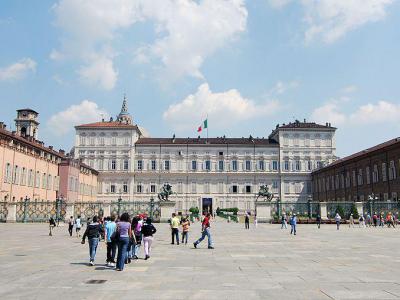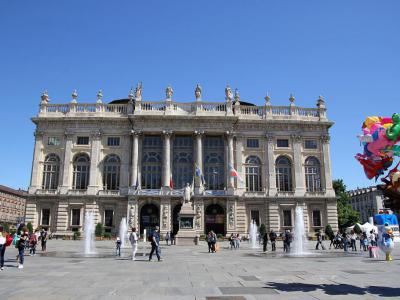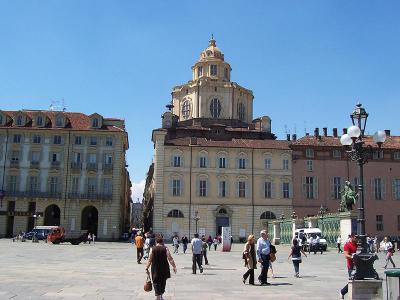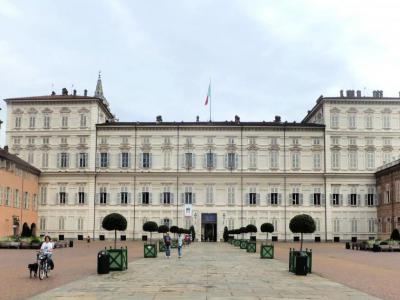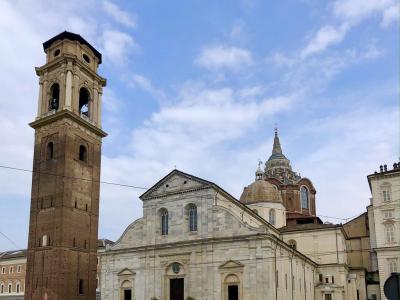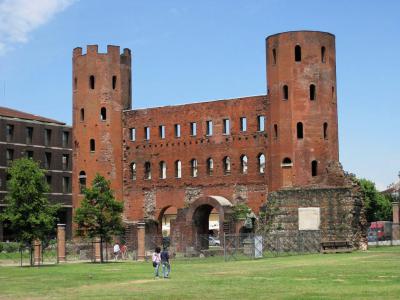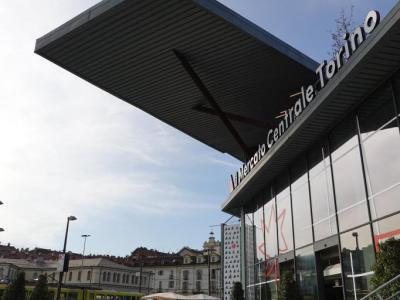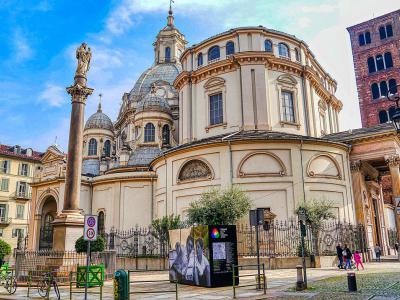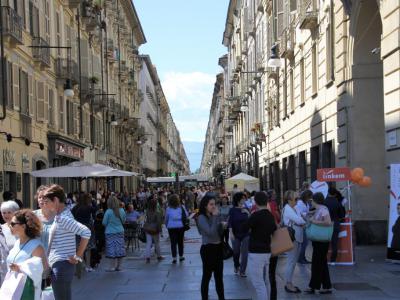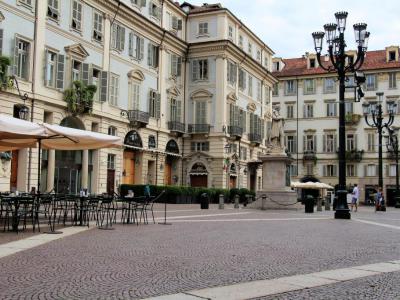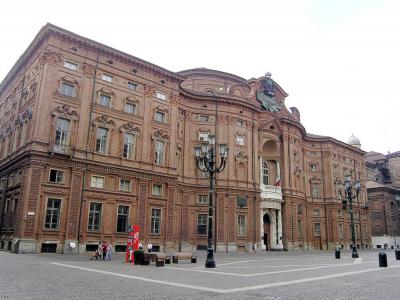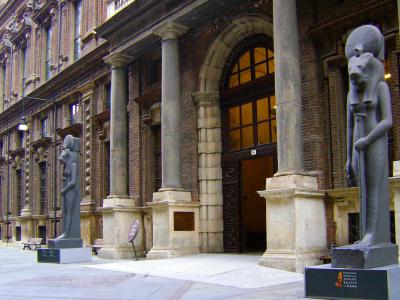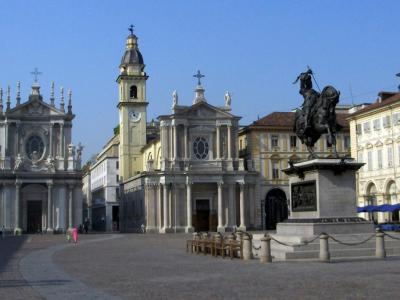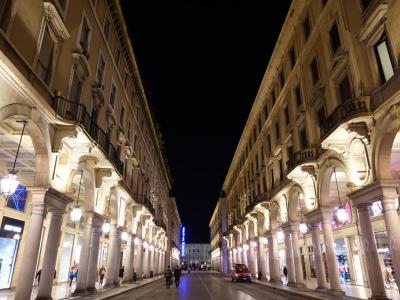Audio Guide: Turin Introduction Walking Tour (Self Guided), Turin
Mark Twain once wrote that Turin’s streets are “extravagantly wide” and its houses stretch “as straight as an arrow”-and he was not exaggerating.
Turin's story begins with the Taurini, a Celtic tribe whose name is tied to the word for “mountain.” They lived at the foot of the Alps before the Romans arrived. In 28 BC, the Romans founded Taurinorum here, designing it in their typical grid pattern, which still shapes the city center. The Palatine Gate is the best reminder of that era, as it once served as a main entry point to the Roman city and still stands as one of the best-preserved Roman structures in northern Italy.
After the fall of Rome, Turin passed through centuries of shifting control. Lombards and Franks left their marks, but it was the House of Savoy that truly set the course of the city’s destiny. From the 13th century onward, the Savoy family used Turin as a base, and in the 16th century they elevated it to the capital of their duchy. This new status brought urban transformation. Streets were broadened, squares carved out, and architects introduced a skyline of domes and palaces. Among them, the Carignano Palace became an emblem of the period. The palace was the birthplace of King Vittorio Emanuele II, the first king of unified Italy, and the eventual home to the Italian Parliament between 1861 and 1865.
During the 17th and 18th centuries, Turin grew in prestige, culture, and science. The Savoys founded institutions such as the University of Turin and the Academy of Sciences, linking the city with Europe’s Enlightenment currents.
The 19th century brought dramatic change with the movement for Italian unification. Turin emerged as a hub of political debate and leadership. When the Kingdom of Italy was proclaimed in 1861, Turin was chosen as its first capital. The founding of Fiat in 1899 transformed it into Italy’s motor capital, reshaping its economy well into the 20th century.
The streets that impressed Mark Twain still guide Turin’s story today. Walk them and you’ll find echoes of Rome, the elegance of the Savoys, the fire of Italian unification, and the hum of an industrial powerhouse. Step onto these “extravagantly wide” avenues, and you’re walking through the very heart of Turin’s past and present.
Turin's story begins with the Taurini, a Celtic tribe whose name is tied to the word for “mountain.” They lived at the foot of the Alps before the Romans arrived. In 28 BC, the Romans founded Taurinorum here, designing it in their typical grid pattern, which still shapes the city center. The Palatine Gate is the best reminder of that era, as it once served as a main entry point to the Roman city and still stands as one of the best-preserved Roman structures in northern Italy.
After the fall of Rome, Turin passed through centuries of shifting control. Lombards and Franks left their marks, but it was the House of Savoy that truly set the course of the city’s destiny. From the 13th century onward, the Savoy family used Turin as a base, and in the 16th century they elevated it to the capital of their duchy. This new status brought urban transformation. Streets were broadened, squares carved out, and architects introduced a skyline of domes and palaces. Among them, the Carignano Palace became an emblem of the period. The palace was the birthplace of King Vittorio Emanuele II, the first king of unified Italy, and the eventual home to the Italian Parliament between 1861 and 1865.
During the 17th and 18th centuries, Turin grew in prestige, culture, and science. The Savoys founded institutions such as the University of Turin and the Academy of Sciences, linking the city with Europe’s Enlightenment currents.
The 19th century brought dramatic change with the movement for Italian unification. Turin emerged as a hub of political debate and leadership. When the Kingdom of Italy was proclaimed in 1861, Turin was chosen as its first capital. The founding of Fiat in 1899 transformed it into Italy’s motor capital, reshaping its economy well into the 20th century.
The streets that impressed Mark Twain still guide Turin’s story today. Walk them and you’ll find echoes of Rome, the elegance of the Savoys, the fire of Italian unification, and the hum of an industrial powerhouse. Step onto these “extravagantly wide” avenues, and you’re walking through the very heart of Turin’s past and present.
How it works: Download the app "GPSmyCity: Walks in 1K+ Cities" from Apple App Store or Google Play Store to your mobile phone or tablet. The app turns your mobile device into a personal tour guide and its built-in GPS navigation functions guide you from one tour stop to next. The app works offline, so no data plan is needed when traveling abroad.
Turin Introduction Walking Tour Map
Guide Name: Turin Introduction Walking Tour
Guide Location: Italy » Turin (See other walking tours in Turin)
Guide Type: Self-guided Walking Tour (Sightseeing)
# of Attractions: 14
Tour Duration: 2 Hour(s)
Travel Distance: 3.4 Km or 2.1 Miles
Author: DanaOffice
Sight(s) Featured in This Guide:
Guide Location: Italy » Turin (See other walking tours in Turin)
Guide Type: Self-guided Walking Tour (Sightseeing)
# of Attractions: 14
Tour Duration: 2 Hour(s)
Travel Distance: 3.4 Km or 2.1 Miles
Author: DanaOffice
Sight(s) Featured in This Guide:
- Piazza Castello (Castle Square)
- Madame Palace and Civic Museum of Ancient Art
- Real Chiesa di San Lorenzo (Royal Church of Saint Lawrence)
- Royal Palace and Armory of Turin
- Duomo di Torino e Cappella della Sacra Sindone (Turin Cathedral and Chapel of the Holy Shroud)
- Porta Palatina (Palatine Gate)
- Mercato Centrale Torino (Torino Central Market)
- Santuario della Consolata (Sanctuary of the Consolation)
- Via Garibaldi (Garibaldi Street)
- Piazza Carignano (Carignano Square)
- Palazzo Carignano (Carignano Palace)
- Museo Egizio (Egyptian Museum)
- Piazza San Carlo (San Carlo Square)
- Via Roma (Rome Street)
1) Piazza Castello (Castle Square) (must see)
Castle Square has been at the heart of Turin since 1584, when architect Ascanio Vitozzi drew it up for the House of Savoy, eager to make their new capital look the part. Think of it as urban planning with a touch of dynastic pride: a space designed for parades, ceremonies, and the occasional show of power.
At its center stands Madama Palace, a building with something of an identity crisis. The medieval towers speak of fortifications and sieges, while Filippo Juvarra’s baroque façade, added in the 18th century, looks ready for a royal ball. Today it houses the Civic Museum of Ancient Art, where you can walk from Roman artifacts to Renaissance paintings without ever leaving the building-time travel made easy.
The square’s borders are no less impressive. The Royal Palace, once the Savoy residence, radiates authority even without its kings. The Church of Saint Lawrence, designed by Guarino Guarini, takes baroque geometry to dizzying new heights, a reminder that architecture here was as much about spectacle as devotion. Meanwhile, the arcaded streets framing the square provide a steady rhythm of shops and cafés, where history meets espresso in the most Italian way possible.
For visitors, Castle Square delivers Turin in one glance: Roman echoes, Savoy ambition, baroque elegance, and modern bustle layered together. It’s a space that doesn’t just tell the city’s story-it performs it, day after day, under the same open sky.
At its center stands Madama Palace, a building with something of an identity crisis. The medieval towers speak of fortifications and sieges, while Filippo Juvarra’s baroque façade, added in the 18th century, looks ready for a royal ball. Today it houses the Civic Museum of Ancient Art, where you can walk from Roman artifacts to Renaissance paintings without ever leaving the building-time travel made easy.
The square’s borders are no less impressive. The Royal Palace, once the Savoy residence, radiates authority even without its kings. The Church of Saint Lawrence, designed by Guarino Guarini, takes baroque geometry to dizzying new heights, a reminder that architecture here was as much about spectacle as devotion. Meanwhile, the arcaded streets framing the square provide a steady rhythm of shops and cafés, where history meets espresso in the most Italian way possible.
For visitors, Castle Square delivers Turin in one glance: Roman echoes, Savoy ambition, baroque elegance, and modern bustle layered together. It’s a space that doesn’t just tell the city’s story-it performs it, day after day, under the same open sky.
2) Madame Palace and Civic Museum of Ancient Art
Madama Palace, planted in the middle of Castle Square, is a building with a split personality-and that’s what makes it fascinating. Its story begins in Roman Taurinorum, where two towers flanked a gate on the Decumanus Maximus, the city’s main east–west street. After Rome’s collapse, the gate did not retire quietly; it became part of the medieval defenses, proving that even ruins can find second careers.
By the 14th century, the property belonged to the Savoia-Acaja, a junior branch of the ruling dynasty. Prince Ludovico of Acaia rebuilt it into a square complex with a courtyard and four corner towers, details you can still spot today if you step around to the back.
In the 17th century, Christine Marie of France claimed the palace, enclosing the courtyard and upgrading the apartments to suit a royal widow. A few decades later, Marie Jeanne Baptiste of Savoy-Nemours moved in, and the nickname “Madama” stuck. The early 1700s brought in architect Filippo Juvarra, who gave the building its baroque white-stone façade. His grand project stopped midway in 1721, leaving the palace in its current form: part fortress, part theatre set.
The palace later moonlighted as the home of the Subalpine Senate before settling into its modern role. Since 1934, it has housed the Civic Museum of Ancient Art, with 35 rooms spanning Roman archaeology, medieval sculpture, Renaissance paintings, and decorative arts ranging from ivories to textiles.
For visitors, Madama Palace is more than a monument-it’s Turin’s history edited into one eccentric, unforgettable volume.
By the 14th century, the property belonged to the Savoia-Acaja, a junior branch of the ruling dynasty. Prince Ludovico of Acaia rebuilt it into a square complex with a courtyard and four corner towers, details you can still spot today if you step around to the back.
In the 17th century, Christine Marie of France claimed the palace, enclosing the courtyard and upgrading the apartments to suit a royal widow. A few decades later, Marie Jeanne Baptiste of Savoy-Nemours moved in, and the nickname “Madama” stuck. The early 1700s brought in architect Filippo Juvarra, who gave the building its baroque white-stone façade. His grand project stopped midway in 1721, leaving the palace in its current form: part fortress, part theatre set.
The palace later moonlighted as the home of the Subalpine Senate before settling into its modern role. Since 1934, it has housed the Civic Museum of Ancient Art, with 35 rooms spanning Roman archaeology, medieval sculpture, Renaissance paintings, and decorative arts ranging from ivories to textiles.
For visitors, Madama Palace is more than a monument-it’s Turin’s history edited into one eccentric, unforgettable volume.
3) Real Chiesa di San Lorenzo (Royal Church of Saint Lawrence)
The Royal Church of Saint Lawrence was born out of battlefield glory. On August 10, 1557-the Feast of Saint Lawrence-Emmanuel Philibert, Duke of Savoy, defeated the French at the Battle of Saint-Quentin. With victory came the return of Turin and Savoy, and the duke marked the occasion by shifting his capital to Turin and commissioning a church for his patron saint.
The design eventually landed in the hands of Guarino Guarini, an architect who was never content with straight lines and safe choices. Between 1668 and 1687, he transformed the project into a masterclass of baroque ingenuity. The floor plan morphs as you move upward: square at the base, octagon above, then a Greek cross, and finally a circular dome stitched together by eight ribs. The dome itself is the real spectacle-interlacing arches form patterns that recall Islamic star motifs, topped by an octagonal lantern. When sunlight cuts through just right, locals swear you can see the unsettling outline of the so-called “face of the devil.”
From Castle Square, the façade hardly announces the wonders inside, but once you step in, the space changes mood dramatically. Marble, gilding, and Guarini’s daring geometry conspire to overwhelm the eye in the best way possible. Saint Lawrence is more than a church: it’s a theatrical demonstration of the Savoys’ appetite for grandeur, staged in stone and light. For visitors, it’s a rare chance to see how power, faith, and a flair for geometry were fused into one unforgettable building.
The design eventually landed in the hands of Guarino Guarini, an architect who was never content with straight lines and safe choices. Between 1668 and 1687, he transformed the project into a masterclass of baroque ingenuity. The floor plan morphs as you move upward: square at the base, octagon above, then a Greek cross, and finally a circular dome stitched together by eight ribs. The dome itself is the real spectacle-interlacing arches form patterns that recall Islamic star motifs, topped by an octagonal lantern. When sunlight cuts through just right, locals swear you can see the unsettling outline of the so-called “face of the devil.”
From Castle Square, the façade hardly announces the wonders inside, but once you step in, the space changes mood dramatically. Marble, gilding, and Guarini’s daring geometry conspire to overwhelm the eye in the best way possible. Saint Lawrence is more than a church: it’s a theatrical demonstration of the Savoys’ appetite for grandeur, staged in stone and light. For visitors, it’s a rare chance to see how power, faith, and a flair for geometry were fused into one unforgettable building.
4) Royal Palace and Armory of Turin (must see)
The Royal Palace of Turin was the command center of the House of Savoy, the dynasty that managed to turn a regional foothold into a European power. When the Savoys shifted their capital from Chambéry to Turin in the 16th century, they needed a residence to match their ambitions. Regent Christina Maria of France ordered a major expansion in 1645, choosing the site of the old Bishop’s Palace. Over the next centuries, architects like Filippo Juvarra and Benedetto Alfieri gave the complex its baroque polish, while additions such as the Chiablese Palace and the Chapel of the Holy Shroud broadened its reach-because what dynasty doesn’t want both more space and a sacred relic in the backyard?
From the outside, the palace looks dignified rather than ostentatious. Step inside, though, and restraint gives way to theater: gilded stucco, chandeliers that seem designed to outshine each other, walls hung with tapestries, and furniture carved to impress. For two centuries, this was the stage where the Savoys displayed their authority, before Italy’s monarchy bowed out after World War II. Since then, the palace has belonged to the state and has taken its place on UNESCO’s World Heritage list.
Linked directly to the palace is the Royal Armory, created in 1837 by Charles Albert of Savoy. Here the past is lined up on either side: medieval armor, ornate firearms, and even pieces tied to Napoleon. The collection sits in the Galleria Beaumont, an opulent hall where baroque decoration meets military might. Between the palace’s gilded salons and the armory’s glinting steel, visitors find Turin’s history laid out as both ceremony and spectacle.
From the outside, the palace looks dignified rather than ostentatious. Step inside, though, and restraint gives way to theater: gilded stucco, chandeliers that seem designed to outshine each other, walls hung with tapestries, and furniture carved to impress. For two centuries, this was the stage where the Savoys displayed their authority, before Italy’s monarchy bowed out after World War II. Since then, the palace has belonged to the state and has taken its place on UNESCO’s World Heritage list.
Linked directly to the palace is the Royal Armory, created in 1837 by Charles Albert of Savoy. Here the past is lined up on either side: medieval armor, ornate firearms, and even pieces tied to Napoleon. The collection sits in the Galleria Beaumont, an opulent hall where baroque decoration meets military might. Between the palace’s gilded salons and the armory’s glinting steel, visitors find Turin’s history laid out as both ceremony and spectacle.
5) Duomo di Torino e Cappella della Sacra Sindone (Turin Cathedral and Chapel of the Holy Shroud)
The Shroud of Turin has stirred fascination for centuries, tied to the Savoy family since 1453 and still regarded as one of the city’s most famous treasures. These days it rests in a climate-controlled glass case inside the Baroque Chapel of the Holy Shroud, linked directly to both Turin Cathedral and the Royal Palace. The chapel itself was the brainchild of Guarino Guarini, a priest-architect who preferred geometry with a flair. In the late 17th century he designed a dome so intricate that light seems to bend into patterns of mystery, amplifying the aura of the relic it protects.
Turin Cathedral, built between 1491 and 1498, has its own layered story. It replaced three earlier churches-one tradition even credits a consecration by Lombard King Agilulf in the early 600s. Dedicated to Saint John the Baptist, the new structure became the city’s main cathedral and, somewhat unusually for Turin, remains its only pure Renaissance building. Its bright marble façade is a calm counterpoint to the surrounding swirl of baroque architecture. Later centuries added their own touches: Filippo Juvarra polished up the bell tower, and Guarini’s chapel gave the complex its most dramatic feature.
That chapel dome is a marvel in itself-six stacked levels rising in a hexagon, crowned by a lantern shaped as a twelve-pointed star with the dove of the Holy Spirit at its center. Step inside, and you’ll find a space that still manages to look both daring and devotional.
The cathedral and chapel together serve as a lesson in contrasts: Renaissance restraint, baroque bravado, and the enduring mystery of the Shroud that continues to draw pilgrims and skeptics alike.
Turin Cathedral, built between 1491 and 1498, has its own layered story. It replaced three earlier churches-one tradition even credits a consecration by Lombard King Agilulf in the early 600s. Dedicated to Saint John the Baptist, the new structure became the city’s main cathedral and, somewhat unusually for Turin, remains its only pure Renaissance building. Its bright marble façade is a calm counterpoint to the surrounding swirl of baroque architecture. Later centuries added their own touches: Filippo Juvarra polished up the bell tower, and Guarini’s chapel gave the complex its most dramatic feature.
That chapel dome is a marvel in itself-six stacked levels rising in a hexagon, crowned by a lantern shaped as a twelve-pointed star with the dove of the Holy Spirit at its center. Step inside, and you’ll find a space that still manages to look both daring and devotional.
The cathedral and chapel together serve as a lesson in contrasts: Renaissance restraint, baroque bravado, and the enduring mystery of the Shroud that continues to draw pilgrims and skeptics alike.
6) Porta Palatina (Palatine Gate)
The Palatine Gate is among the best-preserved Roman gates in northern Italy, a structure that has stood watch since the 1st century CE. Back then, it marked the northern entrance to Julia Augusta Taurinorum, the Roman settlement that grew into modern Turin. The gate opened onto the Decumanus Maximus, the grand east–west street of the Roman grid-a layout that still dictates much of the city’s traffic today. Known to the ancients as the Right-Side Main Gate, its towers still rise nearly 99 feet, while the central span stretches 66 feet across with neat rows of windows. Four arched openings survive: two roomy enough for carts and horses, two narrow enough to remind pedestrians of their place in the Roman pecking order.
The name “Palatine” remains a puzzle. Some think it nodded to a Senate House, others to the City Hall, or even to the amphitheater that once stood in Borgo Dora. Over the years, the gate collected new nicknames-Count’s Gate, Doranea Gate-each tied to whatever role the city imagined for it at the time.
History kept rewriting its script. In the Middle Ages, the gate was fortified into a proper stronghold; by the Renaissance, it had been absorbed into the elegant gardens of the House of Savoy. Nearby, archaeological traces of the amphitheater and Roman walls continue to hint at the larger settlement that once surrounded it.
Now planted in Cesare Augusto Square, the Palatine Gate offers more than a backdrop for photos-it is a reminder that Turin’s streets have been funneling people and trade for nearly two millennia, and they’re not about to stop.
The name “Palatine” remains a puzzle. Some think it nodded to a Senate House, others to the City Hall, or even to the amphitheater that once stood in Borgo Dora. Over the years, the gate collected new nicknames-Count’s Gate, Doranea Gate-each tied to whatever role the city imagined for it at the time.
History kept rewriting its script. In the Middle Ages, the gate was fortified into a proper stronghold; by the Renaissance, it had been absorbed into the elegant gardens of the House of Savoy. Nearby, archaeological traces of the amphitheater and Roman walls continue to hint at the larger settlement that once surrounded it.
Now planted in Cesare Augusto Square, the Palatine Gate offers more than a backdrop for photos-it is a reminder that Turin’s streets have been funneling people and trade for nearly two millennia, and they’re not about to stop.
7) Mercato Centrale Torino (Torino Central Market)
Turin’s Central Market may look new, but it owes its existence to nearly two centuries of commerce at Palace Gate, where markets have been buzzing since 1835. The current glass-and-steel pavilion first rose in 2011, was reshaped by star architect Massimiliano Fuksas, and re-launched in 2019 as part of a project modeled on the foodie temples of Florence and Rome. The goal: give Turin’s food heritage a stage worthy of its reputation.
From the outside, the modern façade reflects the city’s present, but step inside and you’re surrounded by flavors that have defined Piedmont for generations. Bakers, butchers, cheesemakers, and pasta-makers work alongside chefs whipping up everything from agnolotti to oysters. Mare Nostrum supplies the fish, Alberto Marchetti keeps gelato lovers happy, and Farmacia del Cambio proves that dining can be as stylish as it is delicious. Add Sicilian street snacks to the mix, and the market feels like a condensed tour of Italy without leaving the hall.
The building also invites exploration beyond food. The second floor balances clothing shops with a cooking school and The Distillery, a lounge bar whose floor-to-ceiling windows make the square itself part of the décor. Upstairs, the third floor hosts events and performances, while in the basement 18th-century ice storage rooms quietly remind visitors that Turin has always known how to preserve its treasures.
Side by side with the sprawling Palace Gate market, the Central Market adds a polished, theatrical note to Turin’s culinary life-proof that tradition here keeps evolving without losing its appetite.
From the outside, the modern façade reflects the city’s present, but step inside and you’re surrounded by flavors that have defined Piedmont for generations. Bakers, butchers, cheesemakers, and pasta-makers work alongside chefs whipping up everything from agnolotti to oysters. Mare Nostrum supplies the fish, Alberto Marchetti keeps gelato lovers happy, and Farmacia del Cambio proves that dining can be as stylish as it is delicious. Add Sicilian street snacks to the mix, and the market feels like a condensed tour of Italy without leaving the hall.
The building also invites exploration beyond food. The second floor balances clothing shops with a cooking school and The Distillery, a lounge bar whose floor-to-ceiling windows make the square itself part of the décor. Upstairs, the third floor hosts events and performances, while in the basement 18th-century ice storage rooms quietly remind visitors that Turin has always known how to preserve its treasures.
Side by side with the sprawling Palace Gate market, the Central Market adds a polished, theatrical note to Turin’s culinary life-proof that tradition here keeps evolving without losing its appetite.
8) Santuario della Consolata (Sanctuary of the Consolation)
The Sanctuary of the Consolata, formally the Basilica of Our Lady of Consolation, has been drawing believers, skeptics, and the simply curious for centuries. Its story begins in the 5th century with a modest chapel near Turin’s Roman walls. By the 12th century, the place was making headlines of its own: a vision of the Virgin was said to appear inside, and a blind pilgrim supposedly walked away with his sight restored. From that moment, the shrine’s reputation snowballed, and the faithful began leaving ex-votos-tokens of gratitude that now cover the walls in staggering numbers, forming a gallery of centuries’ worth of personal miracles.
The church itself has kept pace with its legends. In 1678, Marie Jeanne Baptiste of Savoy-Nemours called in Guarino Guarini, who swapped medieval modesty for a daring elliptical nave and a hexagonal chapel to frame the Marian icon. Filippo Juvarra later upped the drama with a baroque dome, a bell tower that still marks Turin’s skyline, and chapels designed to dazzle. Giovanni Crosato added painted flourishes overhead, while Pietro Anselmetti and Carlo Ceppi contributed a neoclassical façade and crypt, ensuring the building wore every era it passed through.
Step inside today and you’ll find an interior that refuses to settle on one style. Romanesque towers, baroque curves, Gothic icons, and neoclassical touches all compete for attention, unified by a riot of marble and gilding. For visitors, the Consolata isn’t just another church-it’s a living archive of faith, architecture, and human hope, wrapped into one extraordinary space.
The church itself has kept pace with its legends. In 1678, Marie Jeanne Baptiste of Savoy-Nemours called in Guarino Guarini, who swapped medieval modesty for a daring elliptical nave and a hexagonal chapel to frame the Marian icon. Filippo Juvarra later upped the drama with a baroque dome, a bell tower that still marks Turin’s skyline, and chapels designed to dazzle. Giovanni Crosato added painted flourishes overhead, while Pietro Anselmetti and Carlo Ceppi contributed a neoclassical façade and crypt, ensuring the building wore every era it passed through.
Step inside today and you’ll find an interior that refuses to settle on one style. Romanesque towers, baroque curves, Gothic icons, and neoclassical touches all compete for attention, unified by a riot of marble and gilding. For visitors, the Consolata isn’t just another church-it’s a living archive of faith, architecture, and human hope, wrapped into one extraordinary space.
9) Via Garibaldi (Garibaldi Street)
Garibaldi Street ranks among Turin’s oldest and most energetic thoroughfares, a strip where history refuses to stay buried under cobblestones. It began life in the Roman era as the Decumanus Maximus of Julia Augusta Taurinorum, the grand east–west line that stitched together the Decuman Gate and the Praetoria Gate. Fragments of these ancient entrances still peek through the city-one absorbed into Madama Palace, another near Consolation Square. By the Middle Ages, the road had earned the name Dora Grossa, tied to the nearby Dora River and its role as the city’s marketplace. By the 1700s, it had pavement, sidewalks, and no shortage of churches keeping watch over the trade.
The Savoy rulers decided the street needed polish to match their ambitions. They called in architect Benedetto Alfieri, who gave it the uniform façades and measured rhythm of baroque planning. The 19th century added another twist: after Italian unification, the street was rechristened for Giuseppe Garibaldi, the fiery general whose name still marches down its length. Along the way, you’ll spot the churches of the Holy Martyrs, Holy Trinity, and San Dalmazzo, as well as aristocratic palaces, each with stories baked into their walls.
Today, Garibaldi Street runs from Castle Square to Statute Square, free of cars and full of bustle. Boutiques, cafés, and gelaterias sit shoulder to shoulder with historic façades, while markets and musicians keep the street humming. Walking here is less a stroll than a straight shot through two millennia of Turin’s history.
The Savoy rulers decided the street needed polish to match their ambitions. They called in architect Benedetto Alfieri, who gave it the uniform façades and measured rhythm of baroque planning. The 19th century added another twist: after Italian unification, the street was rechristened for Giuseppe Garibaldi, the fiery general whose name still marches down its length. Along the way, you’ll spot the churches of the Holy Martyrs, Holy Trinity, and San Dalmazzo, as well as aristocratic palaces, each with stories baked into their walls.
Today, Garibaldi Street runs from Castle Square to Statute Square, free of cars and full of bustle. Boutiques, cafés, and gelaterias sit shoulder to shoulder with historic façades, while markets and musicians keep the street humming. Walking here is less a stroll than a straight shot through two millennia of Turin’s history.
10) Piazza Carignano (Carignano Square)
Carignano Square may measure only 289 by 108 feet, but its footprint on Italian history is far larger. Laid out in the 17th century during Savoy urban expansion under Duke Vittorio Amedeo I, it became a showcase for baroque ambition. The star of the square is the Carignano Palace, commissioned in 1679 by Prince Emanuele Filiberto di Savoia-Carignano and finished in 1685 to Guarino Guarini’s design. Its undulating brick façade is a baroque statement piece, proving that curves can make just as bold a point as straight lines.
The palace is also where national politics found a stage. It was the birthplace of Vittorio Emanuele II, later crowned Italy’s first king, and the balcony from which King Charles Albert declared the Albertine Statute in 1848, giving the Kingdom of Sardinia its constitution. In the 1860s, the same halls hosted Italy’s first parliament, turning the square into a symbol of the Risorgimento. Today, the palace is home to the National Museum of the Italian Risorgimento, where artifacts and documents retell the drama of unification.
The square doesn’t stop at politics. Across the way is the Carignano Theatre, while Del Cambio Restaurant and Gelateria Pepino add a culinary subplot with menus that have outlasted centuries. A statue of philosopher Vincenzo Gioberti keeps watch from the center, as if still debating ideas with passersby.
For visitors, Carignano Square manages to condense elegance, rebellion, and gelato into one setting-a rare combination even by Turin standards.
The palace is also where national politics found a stage. It was the birthplace of Vittorio Emanuele II, later crowned Italy’s first king, and the balcony from which King Charles Albert declared the Albertine Statute in 1848, giving the Kingdom of Sardinia its constitution. In the 1860s, the same halls hosted Italy’s first parliament, turning the square into a symbol of the Risorgimento. Today, the palace is home to the National Museum of the Italian Risorgimento, where artifacts and documents retell the drama of unification.
The square doesn’t stop at politics. Across the way is the Carignano Theatre, while Del Cambio Restaurant and Gelateria Pepino add a culinary subplot with menus that have outlasted centuries. A statue of philosopher Vincenzo Gioberti keeps watch from the center, as if still debating ideas with passersby.
For visitors, Carignano Square manages to condense elegance, rebellion, and gelato into one setting-a rare combination even by Turin standards.
11) Palazzo Carignano (Carignano Palace)
Carignano Palace on Carignano Square is a baroque showpiece with a strong claim on Italy’s national memory. Commissioned in 1679 by Prince Emanuele Filiberto of Savoy-Carignano, who fancied himself something of an architecture critic, the palace was given form by Guarino Guarini. He turned brick into theater, bending the façade into an undulating sweep that still startles anyone expecting straight lines. Inside, stucco and frescoes covered the halls, while a forecourt and decorative windows doubled as a military brag sheet, commemorating the Carignan Regiment’s campaigns.
The palace, however, was not content with being merely handsome. It became a cradle of personalities who would ripple through European history. Marie-Louise of Savoy, later a confidant of Marie Antoinette, was born here, as was Prince Charles Emmanuel. Most famously, in 1820, the future King Vittorio Emanuele II-Italy’s first monarch after unification-entered the world under this roof. Fate seemed to enjoy dramatic timing, because only decades later the palace hosted the first Italian Parliament, from 1848 to 1861. Within its chambers, fiery debates shaped the new nation, proving the palace could serve as both royal nursery and republican stage without missing a beat.
Today, Carignano Palace holds the National Museum of the Italian Risorgimento. Visitors can sift through documents, weapons, uniforms, and art that tell the story of unification, all while standing inside a UNESCO-listed Savoy residence. It’s not every day you get to tour a building that doubled as both birthplace of a king and birthplace of a country.
The palace, however, was not content with being merely handsome. It became a cradle of personalities who would ripple through European history. Marie-Louise of Savoy, later a confidant of Marie Antoinette, was born here, as was Prince Charles Emmanuel. Most famously, in 1820, the future King Vittorio Emanuele II-Italy’s first monarch after unification-entered the world under this roof. Fate seemed to enjoy dramatic timing, because only decades later the palace hosted the first Italian Parliament, from 1848 to 1861. Within its chambers, fiery debates shaped the new nation, proving the palace could serve as both royal nursery and republican stage without missing a beat.
Today, Carignano Palace holds the National Museum of the Italian Risorgimento. Visitors can sift through documents, weapons, uniforms, and art that tell the story of unification, all while standing inside a UNESCO-listed Savoy residence. It’s not every day you get to tour a building that doubled as both birthplace of a king and birthplace of a country.
12) Museo Egizio (Egyptian Museum) (must see)
The Egyptian Museum in Turin manages to be both proudly local and strikingly global-a Piedmontese institution that has been obsessed with the Nile since 1630. That was the year the Mensa Isiaca, a bronze altar table bristling with hieroglyphs, found its way to Turin. The Savoy rulers were so intrigued that King Charles Emmanuel III sent Vitaliano Donati to Egypt in 1753, who obligingly returned with hundreds of artifacts from Karnak and Coptos. Think of it as Turin’s first “unboxing” of Egypt.
The real jackpot arrived in 1824, when King Charles Felix snapped up Bernardino Drovetti’s collection of more than 5,000 items-statues, papyri, mummies, the works. Practically overnight, Turin leapfrogged into the spotlight of Egyptology, even before Cairo had its own museum. A steady flow of new finds followed, not least from the digs of archaeologist Ernesto Schiaparelli in the early 20th century, ensuring the museum’s shelves were never short of wonders.
Today, the institution houses about 37,000 objects, though a more digestible 3,000 are on display. Visitors can expect everything from colossal New Kingdom statues to fragile papyri (including one with some surprisingly risqué illustrations), as well as household objects that make ancient Egypt feel oddly familiar. The undisturbed tomb of Kha and Merit, complete with funerary treasures, remains one of its crown jewels, while the Temple of Ellesija-gifted to Italy in the 1960s-adds monumental flair.
The museum itself has also reinvented its stage, with renovations in 2006 and a dramatic reimagining in 2015 by designer Dante Ferretti. By 2019, more than 850,000 visitors had wandered its halls, proof that Turin’s passion for Egypt still resonates. For travelers, the museum offers not just artifacts but a storyline-Egypt’s long arc of history told with Turin as its unlikely narrator.
The real jackpot arrived in 1824, when King Charles Felix snapped up Bernardino Drovetti’s collection of more than 5,000 items-statues, papyri, mummies, the works. Practically overnight, Turin leapfrogged into the spotlight of Egyptology, even before Cairo had its own museum. A steady flow of new finds followed, not least from the digs of archaeologist Ernesto Schiaparelli in the early 20th century, ensuring the museum’s shelves were never short of wonders.
Today, the institution houses about 37,000 objects, though a more digestible 3,000 are on display. Visitors can expect everything from colossal New Kingdom statues to fragile papyri (including one with some surprisingly risqué illustrations), as well as household objects that make ancient Egypt feel oddly familiar. The undisturbed tomb of Kha and Merit, complete with funerary treasures, remains one of its crown jewels, while the Temple of Ellesija-gifted to Italy in the 1960s-adds monumental flair.
The museum itself has also reinvented its stage, with renovations in 2006 and a dramatic reimagining in 2015 by designer Dante Ferretti. By 2019, more than 850,000 visitors had wandered its halls, proof that Turin’s passion for Egypt still resonates. For travelers, the museum offers not just artifacts but a storyline-Egypt’s long arc of history told with Turin as its unlikely narrator.
13) Piazza San Carlo (San Carlo Square) (must see)
Saint Charles’ Square might look like an elegant stage set, but every detail has centuries of politics, culture, and coffee drinking written into it. First drawn out in the 17th century under the Savoy dynasty’s grand makeover of Turin, the square-once called Royal, later Napoleon-was given its symmetry and order by architect Carlo di Castellamonte. The dimensions, 168 by 76 meters, were calculated to impress without overwhelming, and the long arcades still stretch around it like carefully pressed cuffs on a baroque jacket.
The southern end offers drama in stereo: two churches, Santa Cristina and San Carlo Borromeo, facing the square with almost identical façades. Around them stand noble palaces such as the Solaro dei Borgo, home to the Philharmonic Academy since 1839, and the Whist Society, where 19th-century Turin’s elite debated politics as seriously as they did card games. The arcades flow into Via Roma, sheltering shops, cafés, and patisseries where modern chatter continues the square’s long tradition as a meeting ground.
In the center, the equestrian statue of Emanuele Filiberto, Duke of Savoy, strikes a curious pose: sword sliding back into its sheath, a rare image of a general after the battle rather than during it. Sculptor Carlo Marochetti unveiled it in 1838, ensuring that even the square’s focal point mixes power with a hint of theatrical timing.
For nearly two centuries, San Carlo Square has also been Turin’s unofficial salon. At Caffè San Carlo, Caffè Torino, or the Stratta patisserie-famous for chocolates since 1836-politicians, artists, and writers sipped inspiration along with espresso. Since its 2004 redevelopment, the square belongs fully to pedestrians, making it an open-air living room where baroque elegance still frames Turin’s everyday life.
The southern end offers drama in stereo: two churches, Santa Cristina and San Carlo Borromeo, facing the square with almost identical façades. Around them stand noble palaces such as the Solaro dei Borgo, home to the Philharmonic Academy since 1839, and the Whist Society, where 19th-century Turin’s elite debated politics as seriously as they did card games. The arcades flow into Via Roma, sheltering shops, cafés, and patisseries where modern chatter continues the square’s long tradition as a meeting ground.
In the center, the equestrian statue of Emanuele Filiberto, Duke of Savoy, strikes a curious pose: sword sliding back into its sheath, a rare image of a general after the battle rather than during it. Sculptor Carlo Marochetti unveiled it in 1838, ensuring that even the square’s focal point mixes power with a hint of theatrical timing.
For nearly two centuries, San Carlo Square has also been Turin’s unofficial salon. At Caffè San Carlo, Caffè Torino, or the Stratta patisserie-famous for chocolates since 1836-politicians, artists, and writers sipped inspiration along with espresso. Since its 2004 redevelopment, the square belongs fully to pedestrians, making it an open-air living room where baroque elegance still frames Turin’s everyday life.
14) Via Roma (Rome Street)
Rome Street is one of Turin’s grand thoroughfares, a place where the city’s changing rulers left their mark block by block. Its course still follows the cardo maximus, the north–south backbone of the Roman colony Julia Augusta Taurinorum, and while centuries have reshaped the façades, the axis has never lost its prominence.
In the 1600s the Savoy dynasty decided Turin needed the look of a capital, and Rome Street became their canvas. Baroque arcades lined the way, their arches offering rhythm as well as shelter, and soon the porticos filled with cafés, patisseries, and shops. The street’s geometry tied together Castle Square, Saint Charles Square, and Vittorio Veneto Square, giving the city an ordered stage for everyday life and royal ceremony alike.
Skipping forward to the 1930s and another wave of transformation arrived, this time under the Fascist regime. Between 1931 and 1937, architect Marcello Piacentini was tasked with remaking much of the street in Italian Rationalist style. The result was a blend of Novecento Italiano formality, neoclassical restraint, and modernist severity. The stretch between Charles Felix Square and Saint Charles Square gained monumental blocks, among them the Prince of Piedmont Hotel and the former National Hotel. Yet the first section nearer Castle Square was spared and retained its baroque façades, keeping a visual dialogue between past and present.
Today, Rome Street is as much about fashion as it is about history. Luxury boutiques, international brands, and historic cafés share the arcades, making the walk a lesson in architecture that doubles as an invitation to linger.
In the 1600s the Savoy dynasty decided Turin needed the look of a capital, and Rome Street became their canvas. Baroque arcades lined the way, their arches offering rhythm as well as shelter, and soon the porticos filled with cafés, patisseries, and shops. The street’s geometry tied together Castle Square, Saint Charles Square, and Vittorio Veneto Square, giving the city an ordered stage for everyday life and royal ceremony alike.
Skipping forward to the 1930s and another wave of transformation arrived, this time under the Fascist regime. Between 1931 and 1937, architect Marcello Piacentini was tasked with remaking much of the street in Italian Rationalist style. The result was a blend of Novecento Italiano formality, neoclassical restraint, and modernist severity. The stretch between Charles Felix Square and Saint Charles Square gained monumental blocks, among them the Prince of Piedmont Hotel and the former National Hotel. Yet the first section nearer Castle Square was spared and retained its baroque façades, keeping a visual dialogue between past and present.
Today, Rome Street is as much about fashion as it is about history. Luxury boutiques, international brands, and historic cafés share the arcades, making the walk a lesson in architecture that doubles as an invitation to linger.
Walking Tours in Turin, Italy
Create Your Own Walk in Turin
Creating your own self-guided walk in Turin is easy and fun. Choose the city attractions that you want to see and a walk route map will be created just for you. You can even set your hotel as the start point of the walk.
Coffee, Food and Chocolate Tour in Turin
Among other things, the capital of Italy's Piedmont region – Turin – is well known for its rich culinary tradition, which includes long-standing coffee and chocolate culture. There are several cafes and coffee houses in the city that have been in business for hundreds of years.
The most notable of them are found in the historic heart of the city, such as the Caffè al Bicerin.... view more
Tour Duration: 1 Hour(s)
Travel Distance: 2.2 Km or 1.4 Miles
The most notable of them are found in the historic heart of the city, such as the Caffè al Bicerin.... view more
Tour Duration: 1 Hour(s)
Travel Distance: 2.2 Km or 1.4 Miles
The Most Popular Cities
/ view all



